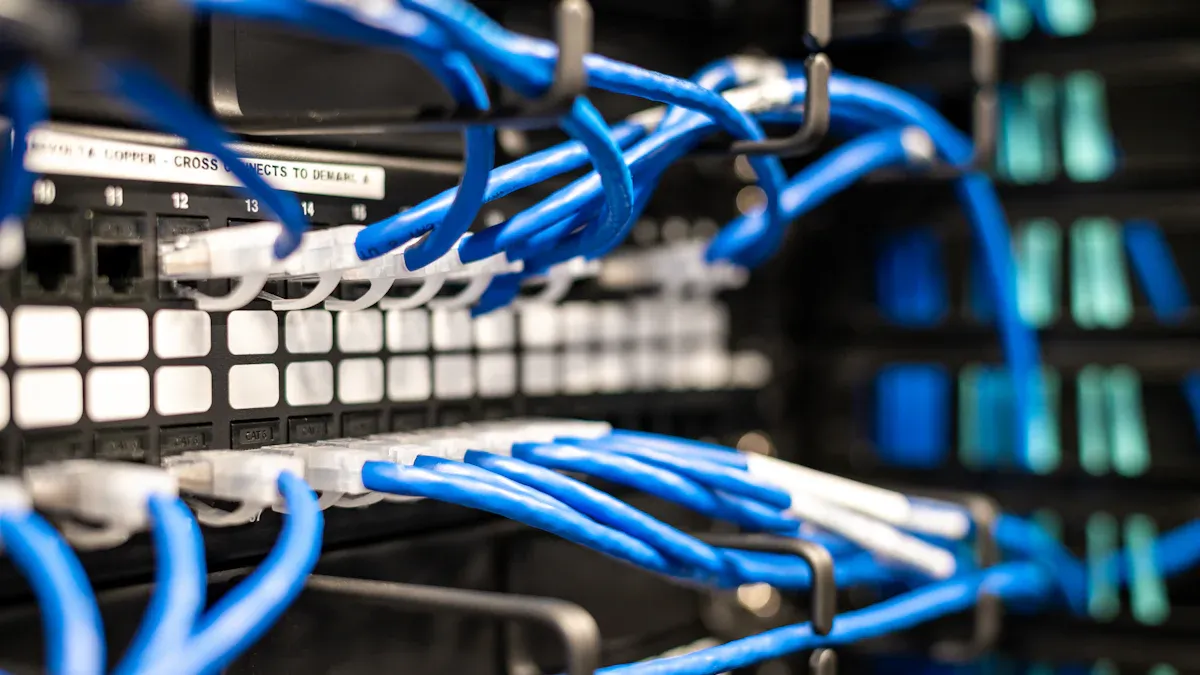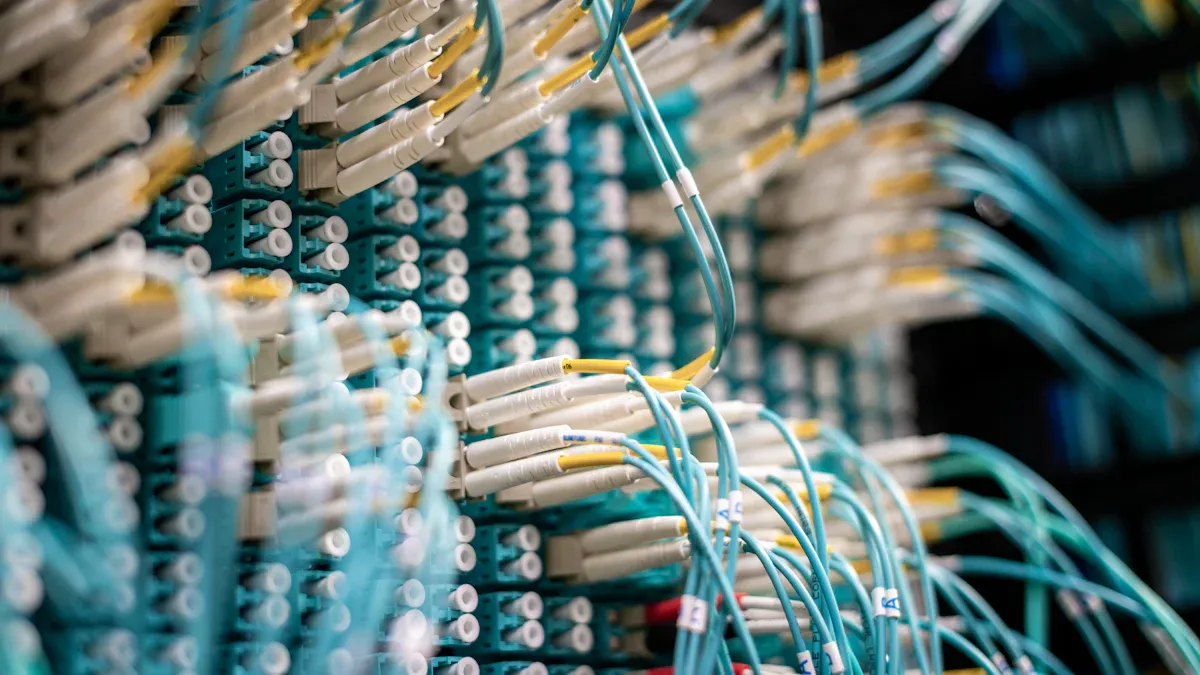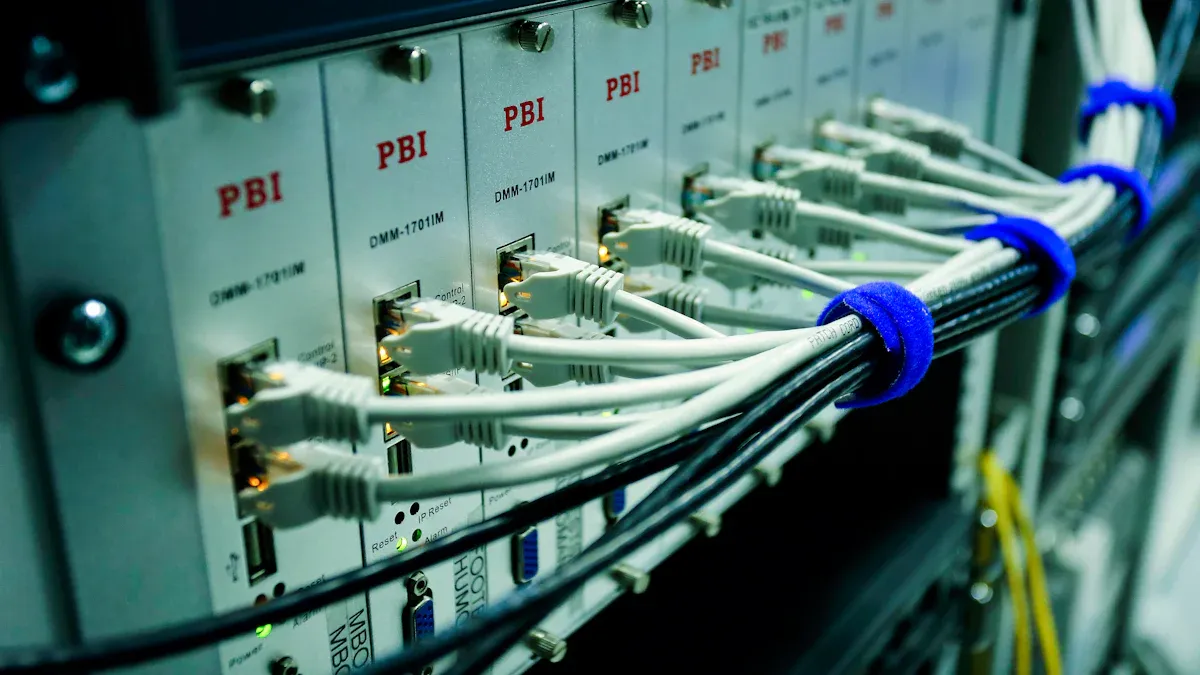How to choose and install an Outdoor Wall Telecom Cabinet, including safety considerations

Outdoor wall telecom cabinets play a vital role in safeguarding sensitive equipment from harsh outdoor conditions. These enclosures, made from durable materials like stainless steel or aluminum, shield your telecom systems from dust, water, and extreme temperatures. High IP ratings, such as IP65 or IP66, ensure reliable protection against environmental threats. Additionally, features like tamper-proof locks and thermal management systems enhance security and prevent overheating. By choosing the right cabinet, you ensure your equipment operates efficiently while staying protected from potential damage.
Key Takeaways
Pick a cabinet with a strong IP rating, like IP65 or IP66, to keep dust and water out.
Use tough materials like stainless steel or aluminum to stop rust and last longer.
Think about future needs by measuring your equipment and picking a cabinet with extra space.
Add safety features like locks that can't be tampered with and cameras to protect your equipment.
Follow safety rules when installing, like grounding properly and using tools with insulation to avoid shocks.
Key Factors to Consider When Choosing an Outdoor Wall Telecom Cabinet

Environmental Conditions
Importance of IP ratings for weatherproofing and waterproofing
When selecting an outdoor telecom enclosure, you must prioritize its ability to withstand environmental challenges. IP ratings, such as IP65 or IP66, indicate the level of protection against dust and water. A higher IP rating ensures that your equipment remains safe during heavy rain or dusty conditions. This is crucial for maintaining uninterrupted telecom operations.
Outdoor enclosures require special attention during extreme weather conditions. Electronics need climate control to survive outdoors. Proper ventilation prevents overheating and condensation damage, while secure connections protect against the elements.
Evaluating site-specific factors like temperature, moisture, and UV exposure
You should evaluate the specific environmental conditions of your installation site. Factors like temperature fluctuations, moisture levels, and UV exposure can significantly impact the durability of your outdoor weatherproof enclosure.
Factor | Description |
|---|---|
Operating Environment | Consider temperature, humidity, sunlight exposure, water, dust levels, and other hazards. |
Waterproofing | Cabinets should endure severe weather, including rain, snow, and extreme temperatures. |
Environmental Considerations | Evaluate seismic activity, wind speeds, pollution levels, and corrosion prevention needs. |
Size and Capacity
Measuring equipment dimensions and planning for future expansion
Choosing a proper size enclosure ensures that your telecom equipment fits securely while leaving room for future upgrades. Measure the dimensions of your equipment carefully and account for additional components you may need later. This approach prevents the need for frequent replacements and saves costs in the long run.
Benefits of compact, wall-mounted outdoor enclosures
Compact, wall-mounted outdoor enclosures save space and provide easy access for maintenance. These designs are ideal for areas with limited space and offer a clean, organized setup. They also enhance protection by keeping equipment off the ground, reducing exposure to water and debris.
Material and Durability
Selecting corrosion-resistant materials like stainless steel or aluminum
The material of your outdoor server cabinet plays a vital role in its durability. Stainless steel and aluminum are excellent choices due to their corrosion resistance. Stainless steel resists rust even in wet or coastal climates, while aluminum is lightweight and naturally resistant to corrosion, making it suitable for humid environments.
Material | Durability Characteristics |
|---|---|
Steel | Strong and durable, excellent protection against physical damage, corrosion-resistant with finishes. |
Aluminum | Lightweight, naturally corrosion-resistant, ideal for humid or coastal environments. |
Composite Materials | Combines strength with flexibility, excellent thermal insulation, effective in extreme temperatures. |
Ensuring UV protection and compliance with NEMA standards
Outdoor enclosures must comply with NEMA type outdoor enclosures standards to ensure they meet safety and durability requirements. UV protection is equally important to prevent material degradation from prolonged sun exposure. This ensures your enclosure remains functional and visually appealing over time.
Security Features
Tamper-proof locks and reinforced doors for theft prevention
Protecting your telecom equipment from theft or tampering starts with robust locking mechanisms. Anti-theft three-point locks are highly effective in deterring unauthorized access. These systems ensure that only authorized personnel can open the cabinet. Tamper-proof designs, such as concealed locks and reinforced hinges, add another layer of security. They prevent tampering attempts and maintain the integrity of your network infrastructure.
Cabinets with reinforced doors and panels provide additional protection against physical attacks. This durability ensures your equipment remains secure even in high-risk areas.
To further enhance security, consider options like alarm systems or motion sensors. These features trigger alerts during unauthorized access attempts, allowing you to respond quickly and protect your equipment.
Additional measures like surveillance and lighting for enhanced security
Adding surveillance and lighting to your outdoor telecom cabinet setup significantly improves security. Surveillance cameras monitor the area around the cabinet, deterring potential intruders. Integrating these cameras with existing security systems provides real-time monitoring and alerts.
Motion-activated lighting is another effective measure. Bright lights discourage unauthorized activity and make it easier to inspect the cabinet during maintenance. Alarm systems and intrusion detection mechanisms also enhance security by triggering alerts when tampering occurs.
Key security enhancements to consider:
Install CCTV cameras for continuous monitoring.
Use motion-activated lights to deter intruders.
Equip cabinets with alarm systems for immediate alerts.
By combining these measures, you create a secure environment for your telecom equipment, ensuring its safety and uninterrupted operation.
Step-by-Step Guide to Installing an Outdoor Wall Telecom Cabinet

Preparation
Choosing a dry, elevated installation site above flood lines
Selecting the right location is critical for protecting your equipment. Choose a dry, elevated site to avoid water damage during heavy rains or floods. Ensure the area is free from excessive dust and debris. Avoid low-lying areas prone to water pooling. A well-ventilated location also helps maintain optimal operating conditions for your telecom cabinet.
Gathering necessary tools and ensuring compliance with safety standards
Before starting the installation, gather all necessary tools, such as a drill, measuring tape, level, and fasteners. Use insulated tools to ensure safety when working near electrical components. Verify that your tools are in good condition to avoid delays or accidents. Always follow local safety standards and guidelines to ensure a compliant and secure installation process.
Mounting the Cabinet
Marking and drilling precise mounting points
Accurate marking and drilling are essential for a stable installation. Follow these steps:
Use a measuring tape to determine the exact placement of the cabinet.
Mark the drill points with a pencil or marker for precision.
Select a masonry or concrete drill bit for tough surfaces.
Drill at a perpendicular angle to ensure the cabinet mounts securely.
Periodically remove debris from the holes to maintain accuracy.
Wearing protective gear, such as safety glasses and gloves, minimizes the risk of injury during this process.
Securing the outdoor enclosure with appropriate fasteners
Once the holes are drilled, align the cabinet with the mounting points. Use durable fasteners, such as stainless steel screws or bolts, to secure the enclosure. Tighten the fasteners evenly to prevent misalignment. A stable and secure mounting prevents vibrations that could damage the equipment inside.
Cable Management
Organizing cables for accessibility and maintenance
Proper cable management ensures your system remains organized and easy to maintain. Group cables based on their function, such as power or communication lines. Use cable ties or clips to keep them neatly arranged. Label each cable for quick identification during future maintenance. This organization reduces the risk of accidental disconnections or damage.
Ensuring proper cable entry points and sealing to prevent water ingress
Unsealed cable entry points can allow moisture to infiltrate, leading to equipment damage. Use cable entry seals to create a watertight barrier around the cables. These seals prevent water, dust, and air from entering the enclosure. Apply weatherproof sealants or caulk around any gaps to enhance protection. This step is crucial for safeguarding sensitive electronics from environmental hazards.
Final Checks
Verifying stability, alignment, and drainage
Before completing the installation, you must confirm that the outdoor wall telecom cabinet is stable and properly aligned. A stable cabinet prevents vibrations that could damage internal components. Use a level to check the alignment of the enclosure. If the cabinet tilts, adjust the fasteners to ensure it sits evenly against the wall.
Inspect the mounting points to verify they are secure. Loose fasteners can compromise the cabinet’s stability, especially during strong winds or vibrations. Tighten any screws or bolts that appear loose.
Drainage is another critical factor. Check that the cabinet is slightly tilted forward or has drainage holes at the bottom. This design prevents water from pooling inside the enclosure. If water collects, it can damage sensitive equipment and reduce the cabinet's lifespan. Regularly inspect the drainage system to ensure it remains clear of debris.
Testing equipment functionality and ventilation systems
Once the cabinet is securely mounted, test the functionality of the equipment inside. Power on the devices and confirm they operate as expected. Check all connections, including power and communication cables, to ensure they are secure and functioning correctly.
Proper ventilation is essential for maintaining optimal operating conditions. Inspect the ventilation system to confirm it is working efficiently. Fans or cooling units should operate without obstruction. Blocked vents can lead to overheating, which may damage your equipment.
You should also monitor the internal temperature of the cabinet after installation. Use a thermometer or temperature sensor to ensure the enclosure maintains a safe environment for the equipment. Address any issues immediately to avoid long-term damage.
Tip: Schedule regular maintenance checks to keep your cabinet and equipment in top condition.
Safety Considerations During Installation
Electrical Safety
Turning off power supply and using insulated tools
Before starting any installation work, always turn off the power supply to prevent electrical shocks. This step ensures your safety while handling cables and equipment. Use insulated tools specifically designed for electrical work. These tools reduce the risk of accidental contact with live wires. Keep a voltage tester handy to confirm that no current flows through the system before proceeding.
Wearing protective gear and following electrical codes
Wear protective gear, such as rubber gloves and safety goggles, to shield yourself from potential hazards. Adhering to local electrical codes is equally important. These codes provide guidelines for safe installation practices and help you avoid legal or operational issues. Following these standards ensures the safety of both the installer and the equipment.
Proper Grounding
Importance of grounding to prevent electrical hazards
Grounding plays a critical role in protecting your telecom equipment from electrical risks. It prevents damage caused by:
Electrical surges and overvoltage conditions.
Lightning strikes that could harm sensitive components.
Vandalism, by enhancing the durability of the infrastructure.
Proper grounding ensures the reliability of your telecom system and minimizes downtime caused by electrical failures.
Steps to ensure effective grounding for outdoor enclosures
To ground your outdoor enclosure effectively:
Install a grounding rod near the cabinet.
Connect the rod to the cabinet using a copper wire.
Secure the connection with a grounding clamp.
Test the grounding system to confirm its effectiveness.
These steps create a safe environment for your equipment and enhance overall system performance.
Secure Mounting
Assessing wall strength and weight capacity
Evaluate the wall where you plan to mount the cabinet. Ensure it can support the weight of the enclosure and its contents. Weak walls may compromise the stability of the installation, leading to potential hazards. Use a stud finder or consult a structural engineer if necessary.
Using durable fasteners and ensuring stability
Choose high-quality fasteners, such as stainless steel bolts, to secure the cabinet. These fasteners resist corrosion and provide long-term stability. Tighten them evenly to prevent misalignment. A stable installation protects your equipment from vibrations and external forces, ensuring its longevity.
Tip: Always verify that the cabinet complies with industry standards like NEMA 4, NEMA 4X, or IP55. These certifications guarantee protection against environmental factors, ensuring the safety and durability of your outdoor telecom cabinet.
Choosing the right outdoor wall telecom cabinet ensures your equipment remains protected and performs reliably. Focus on environmental suitability, size, and security features to meet your specific needs. Proper installation, including grounding and secure mounting, safeguards against potential hazards. Adhering to safety precautions minimizes risks during setup.
Prioritizing quality and compliance offers long-term benefits:
Compliance with industry standards enhances safety and reduces accident risks.
Cabinets designed for harsh conditions ensure continuous network operation.
To maintain optimal performance and durability:
Use galvanized steel for durability and IP55-rated enclosures for dust and water resistance.
Secure cabinets with appropriate hardware and seal openings to prevent damage.
Regularly inspect and clean to prevent wear and ensure ventilation.
By following these guidelines, you create a robust and efficient telecom infrastructure that withstands environmental challenges and operates seamlessly.
FAQ
What is the purpose of an outdoor wall telecom cabinet?
An outdoor wall telecom cabinet protects your telecom equipment from environmental factors like rain, dust, and UV rays. It ensures the equipment operates efficiently while safeguarding it from theft or tampering.
How do you choose the right size for a telecom cabinet?
Measure your equipment's dimensions and consider future expansion needs. Select a cabinet that accommodates your current setup and leaves room for additional components. This approach prevents frequent replacements.
Why is grounding important during installation?
Grounding prevents electrical hazards like surges and lightning strikes. It protects your equipment and ensures the reliability of your telecom system. Proper grounding minimizes downtime and enhances safety.
What materials are best for outdoor telecom cabinets?
Stainless steel and aluminum are excellent choices. Stainless steel resists rust in wet climates, while aluminum is lightweight and corrosion-resistant. Both materials ensure durability and long-term performance.
How can you enhance the security of your telecom cabinet?
Use tamper-proof locks, reinforced doors, and surveillance cameras. Motion-activated lighting and alarm systems also deter intruders. These measures protect your equipment and maintain uninterrupted operations.
See Also
Selecting The Ideal Mount For Outdoor Telecom Cabinets
Essential Features For Durable Outdoor Telecom Cabinets
Safeguarding Equipment Using Outdoor Telecom Cabinets Effectively
Assessing Material Quality For Outdoor Telecom Cabinets
Exploring The Importance Of Outdoor Communication Cabinets In Telecom
CALL US DIRECTLY
86-13752765943
3A-8, SHUIWAN 1979 SQUARE (PHASE II), NO.111, TAIZI ROAD,SHUIWAN COMMUNITY, ZHAOSHANG STREET, NANSHAN DISTRICT, SHENZHEN, GUANGDONG, CHINA

